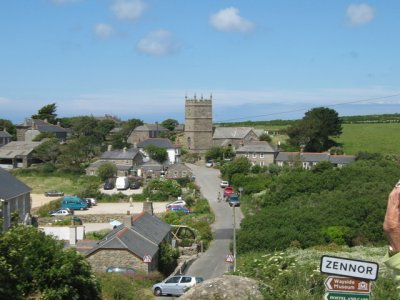


Ancient village famous for a mermaid
www.nationaltrust.org.uk/visit/cornwall/levant-mine-and-beam-engine/zennor-head-walk
Zennor village, lying in a hollow on the wild north coast of the Land's End Peninsula about four miles along the B3306 road from St. Ives. It stands within an ancient landscape of Iron Age fields between high moorland and the stupendous 300 foot sea cliffs of Zennor Head. This feels like a very old place indeed; there has been human settlement in the Zennor area since the early Bronze Age and the echoes of these ancient times are still remarkably strong. The population of the village was 196 at the 2011 census.
The village has the handsome 15th century St. Senara church and its traditional pub built in 1271 - The Tinners Arms - is a popular venue. Zennor is inescapably linked to its legend of a mermaid who is said to have become so enchanted by the sweet voice of a church chorister that she lured him into the sea through her own magical charm.
The church is set in a circular graveyard. The graveyard is an Iron Age site overlaying the Stone Age and Bronze Age boundaries of this ancient area. It is believed that a small Celtic church was built on this site during the 6th century AD.
In 1916, the 'Enrico Parodi', a 339 foot long, 3,800-ton steel vessel, struck Gurnard's Head near Zennor during thick fog. While being towed, it sank off The Carracks and remains there, 30 yards below the surface as a diving attraction.
In 1943, the middle of World War II, No. 4 British Commando were involved in a mock seaborne raid codenamed "Exercise Brandyball", which took place on the 300 foot cliffs at Bosigran, about two miles south west of Zennor. The training exercise was deemed one of the most hazardous and challenging of the war, beginning with a seaborne landing, followed by a climb up the vertical cliffs with full kit to destroy the target, an old disused tin mine.
The Wayside Museum at Zennor has displays on the farming, mining and history of the area along with a working water mill. Zennor Head and the coastal footpath can be reached on foot from the village. Sited next to it is a backpackers' hostel.
The Ancient burial sites of Zennor Quoit and Sperris Quoit can be found on the slopes above the village.
The legend of the mermaid of Zennor concerns a mermaid that visits St. Senara's Church and entices local parish singer Mathey Trewella away. The legend was probably inspired by a 15th-century carved bench-end in the church that shows a mermaid.
Easy two and a half mile walk to the cliffs, following a narrow track that leads to the coast path and onto Zennor Head. Starting from Zennor village and encompassing the peninsula’s diverse flora and fauna, it offers impressive views from the headland looking east and west, and also looking back inland.
David Herbert Richards Lawrence (1885-1930), and his wife lived here during the First World War while he worked on the novel "Women in Love". Fuelled by the fact that his German wife was a cousin of The Red Baron, the Lawrences were driven out of the village in 1917 by suspicious locals who believed they were signalling to German U-Boats lying in wait off the coast.
Patrick Heron CBE (1920-1999), artist who lived in Cornwall until the age of nine and he returned in 1956 to live at "Eagle's Nest", overlooking the cliffs near Zennor. He died peacefully at his home in Zennor in March 1999, at the age of 79, and many of his works are displayed at the Tate Gallery at St. Ives.
John Davey (1812–1891), was a Cornish farmer born nearby who was one of the last people with some traditional knowledge of the Cornish language.
Henry Quick (1792–1857) was a Cornish poet who wrote about rural life in Cornwall.
Zennor Feast Day - 6th of May.
Morvah St. Just-in-Penwith The Wayside Folk Museum St. Ives
The Coastal Footpath The Penwith Peninsula